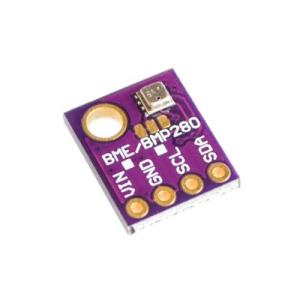pytempsense
pytempsense is library to access BME280 readings over I2C for Raspberry PI's or Tinker boards
pytempsense was developed to access readings of BME280 breakout boards (as shown below) with Python on Raspberry Pis or Tinker boards. These boards can be bought cheaply from AliExpress and co. (Around 3$, 1Q2018). This library uses the official BME280 sensor API driver.
Installation
Connect breakout board
The breakout boards need to be connected to the Raspberry Pi/Tinkerboard by the following connections:
| BME280 | Raspberry Pi |
|---|---|
| VIN | VCC 3.3 V (P1) |
| GND | GND (e.g. P9) |
| SCL | I2C SCL (P5) |
| SDA | I2C SDA (P3) |
After connecting the breakout board you can check if the sensor is recognized by the system using the i2cdetect -y i2cbus command. For Raspberry Pi/Tinkerboards i2cbus is typically 1. If the sensor is recognized the output includes the number 76 or 77. Following is the output when the sensor is recognized correctly.
>>> i2cdetect -y 1
0 1 2 3 4 5 6 7 8 9 a b c d e f
00: -- -- -- -- -- -- -- -- -- -- -- -- --
10: -- -- -- -- -- -- -- -- -- -- -- -- -- -- -- --
20: -- -- -- -- -- -- -- -- -- -- -- -- -- -- -- --
30: -- -- -- -- -- -- -- -- -- -- -- -- -- -- -- --
40: -- -- -- -- -- -- -- -- -- -- -- -- -- -- -- --
50: -- -- -- -- -- -- -- -- -- -- -- -- -- -- -- --
60: -- -- -- -- -- -- -- -- -- -- -- -- -- -- -- --
70: -- -- -- -- -- -- 76 -- `Python library installation
First, you need to install cython in order to build the library:
sudo pip install cython
The library is tested with cython=0.28.1. If you have an older version and problems installing the library you should upgrade cython:
sudo pip install --upgrade cython
After installing cython, checkout the code from the GIT repository:
git clone https://github.com/rbuffat/pytempsense.git
Now you can install the library using the following commands:
cd pytempsense
sudo python setup.py install
Basic usage
If the library is installed correctly, the following code is required to read sensor data.
from pytempsense import BME280
bme280 = BME280(i2cbus=1)
d = bme280.read()i2cbus should thereby correspond to the one used for i2cdetect. The read() method returns a dictionary with the sensor values and a timestamp:
{'pressure': 961.4, 'temperature': 21.9, 'timestamp': 1522700052.958628, 'humidity': 39.2900390625}Advanced usage
The BME280 sensor allows different modes, such as oversampling, filter or sensor mode. These options can be controlled using the BME280 class:
BME280(i2cbus=1,
humidity_oversampling=BME280Oversampling.X1,
pressure_oversampling=BME280Oversampling.X1,
temperature_oversampling=BME280Oversampling.X1,
filter_coeff=BME280Filter.OFF,
standby_time=None,
sensor_mode=BME280SensorPowerMode.FORCED)Please consult the BME280 datasheet to find the values that suits your use case. The default values correspond to the recommended mode for weather monitoring (see Chapter 3.5.1 in BME280 datasheet). The options can be controlled using the helper classes BME280Oversampling, BME280Filter, BME280StandbyTime andBME280SensorPowerMode.
